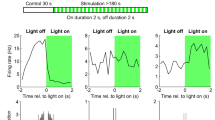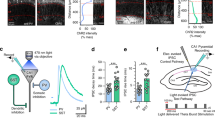Abstract
Homeostatic synaptic scaling alters the strength of synapses to compensate for prolonged changes in network activity and involves both excitatory and inhibitory neurons. The immediate-early gene Narp (neuronal activity–regulated pentraxin) encodes a secreted synaptic protein that can bind to and induce clustering of AMPA receptors (AMPARs). We found that Narp prominently accumulated at excitatory synapses on parvalbumin-expressing interneurons (PV-INs). Increasing network activity resulted in a homeostatic increase of excitatory synaptic strength onto PV-INs that increased inhibitory drive and this response was absent in neurons cultured from Narp−/− mice. Activity-dependent changes in the strength of excitatory inputs on PV-INs in acute hippocampal slices were also dependent on Narp and Narp−/− mice had increased sensitivity to kindling-induced seizures. We propose that Narp recruits AMPARs at excitatory synapses onto PV-INs to rebalance network excitation/inhibition dynamics following episodes of increased circuit activity.
This is a preview of subscription content, access via your institution
Access options
Subscribe to this journal
Receive 12 print issues and online access
$209.00 per year
only $17.42 per issue
Buy this article
- Purchase on Springer Link
- Instant access to full article PDF
Prices may be subject to local taxes which are calculated during checkout








Similar content being viewed by others
References
Turrigiano, G.G. & Nelson, S.B. Hebb and homeostasis in neuronal plasticity. Curr. Opin. Neurobiol. 10, 358–364 (2000).
Turrigiano, G.G. Homeostatic plasticity in neuronal networks: the more things change, the more they stay the same. Trends Neurosci. 22, 221–227 (1999).
Turrigiano, G.G. & Nelson, S.B. Homeostatic plasticity in the developing nervous system. Nat. Rev. Neurosci. 5, 97–107 (2004).
Chowdhury, S. et al. Arc/Arg3.1 interacts with the endocytic machinery to regulate AMPA receptor trafficking. Neuron 52, 445–459 (2006).
Shepherd, J.D. et al. Arc/Arg3.1 mediates homeostatic synaptic scaling of AMPA receptors. Neuron 52, 475–484 (2006).
Park, S. et al. Elongation factor 2 and fragile X mental retardation protein control the dynamic translation of Arc/Arg3.1 essential for mGluR-LTD. Neuron 59, 70–83 (2008).
Tsui, C.C. et al. Narp, a novel member of the pentraxin family, promotes neurite outgrowth and is dynamically regulated by neuronal activity. J. Neurosci. 16, 2463–2478 (1996).
Xu, D. et al. Narp and NP1 form heterocomplexes that function in developmental and activity-dependent synaptic plasticity. Neuron 39, 513–528 (2003).
Dodds, D.C., Omeis, I.A., Cushman, S.J., Helms, J.A. & Perin, M.S. Neuronal pentraxin receptor, a novel putative integral membrane pentraxin that interacts with neuronal pentraxin 1 and 2 and taipoxin-associated calcium-binding protein 49. J. Biol. Chem. 272, 21488–21494 (1997).
Sia, G.M. et al. Interaction of the N-terminal domain of the AMPA receptor GluR4 subunit with the neuronal pentraxin NP1 mediates GluR4 synaptic recruitment. Neuron 55, 87–102 (2007).
Cho, R.W. et al. mGluR1/5-dependent long-term depression requires the regulated ectodomain cleavage of neuronal pentraxin NPR by TACE. Neuron 57, 858–871 (2008).
Bjartmar, L. et al. Neuronal pentraxins mediate synaptic refinement in the developing visual system. J. Neurosci. 26, 6269–6281 (2006).
Kinney, J.W. et al. A specific role for NR2A-containing NMDA receptors in the maintenance of parvalbumin and GAD67 immunoreactivity in cultured interneurons. J. Neurosci. 26, 1604–1615 (2006).
Mi, R. et al. Differing mechanisms for glutamate receptor aggregation on dendritic spines and shafts in cultured hippocampal neurons. J. Neurosci. 22, 7606–7616 (2002).
O'Brien, R.J. et al. Synaptic clustering of AMPA receptors by the extracellular immediate-early gene product Narp. Neuron 23, 309–323 (1999).
Doyle, S., Pyndiah, S., De Gois, S. & Erickson, J.D. Excitation-transcription coupling via calcium/calmodulin-dependent protein kinase/ERK1/2 signaling mediates the coordinate induction of VGLUT2 and Narp triggered by a prolonged increase in glutamatergic synaptic activity. J. Biol. Chem. 285, 14366–14376 (2010).
Honig, M.G. & Hume, R.I. Fluorescent carbocyanine dyes allow living neurons of identified origin to be studied in long-term cultures. J. Cell Biol. 103, 171–187 (1986).
O'Brien, R. et al. Synaptically targeted narp plays an essential role in the aggregation of AMPA receptors at excitatory synapses in cultured spinal neurons. J. Neurosci. 22, 4487–4498 (2002).
Freund, T.F. & Buzsaki, G. Interneurons of the hippocampus. Hippocampus 6, 347–470 (1996).
Härtig, W. et al. Cortical neurons immunoreactive for the potassium channel Kv3.1b subunit are predominantly surrounded by perineuronal nets presumed as a buffering system for cations. Brain Res. 842, 15–29 (1999).
Härtig, W., Brauer, K. & Bruckner, G. Wisteria floribunda agglutinin-labelled nets surround parvalbumin-containing neurons. Neuroreport 3, 869–872 (1992).
Kosaka, T. & Heizmann, C.W. Selective staining of a population of parvalbumin-containing GABAergic neurons in the rat cerebral cortex by lectins with specific affinity for terminal N-acetylgalactosamine. Brain Res. 483, 158–163 (1989).
Brückner, G. et al. Acute and long-lasting changes in extracellular-matrix chondroitin-sulphate proteoglycans induced by injection of chondroitinase ABC in the adult rat brain. Exp. Brain Res. 121, 300–310 (1998).
Geiger, J.R. et al. Relative abundance of subunit mRNAs determines gating and Ca2+ permeability of AMPA receptors in principal neurons and interneurons in rat CNS. Neuron 15, 193–204 (1995).
Kawaguchi, Y., Katsumaru, H., Kosaka, T., Heizmann, C.W. & Hama, K. Fast spiking cells in rat hippocampus (CA1 region) contain the calcium-binding protein parvalbumin. Brain Res. 416, 369–374 (1987).
Koh, D.S., Geiger, J.R., Jonas, P. & Sakmann, B. Ca2+-permeable AMPA and NMDA receptor channels in basket cells of rat hippocampal dentate gyrus. J. Physiol. (Lond.) 485, 383–402 (1995).
Reti, I.M. & Baraban, J.M. Sustained increase in Narp protein expression following repeated electroconvulsive seizure. Neuropsychopharmacology 23, 439–443 (2000).
Fuchs, E.C. et al. Recruitment of parvalbumin-positive interneurons determines hippocampal function and associated behavior. Neuron 53, 591–604 (2007).
Morimoto, K., Fahnestock, M. & Racine, R.J. Kindling and status epilepticus models of epilepsy: rewiring the brain. Prog. Neurobiol. 73, 1–60 (2004).
Alle, H., Jonas, P. & Geiger, J.R. PTP and LTP at a hippocampal mossy fiber-interneuron synapse. Proc. Natl. Acad. Sci. USA 98, 14708–14713 (2001).
Maffei, A., Nataraj, K., Nelson, S.B. & Turrigiano, G.G. Potentiation of cortical inhibition by visual deprivation. Nature 443, 81–84 (2006).
Nissen, W., Szabo, A., Somogyi, J., Somogyi, P. & Lamsa, K.P. Cell type-specific long-term plasticity at glutamatergic synapses onto hippocampal interneurons expressing either parvalbumin or CB1 cannabinoid receptor. J. Neurosci. 30, 1337–1347 (2010).
Cardin, J.A. et al. Driving fast-spiking cells induces gamma rhythm and controls sensory responses. Nature 459, 663–667 (2009).
Hensch, T.K. Critical period plasticity in local cortical circuits. Nat. Rev. Neurosci. 6, 877–888 (2005).
Gogolla, N., Caroni, P., Luthi, A. & Herry, C. Perineuronal nets protect fear memories from erasure. Science 325, 1258–1261 (2009).
Bekenstein, J.W. & Lothman, E.W. Dormancy of inhibitory interneurons in a model of temporal lobe epilepsy. Science 259, 97–100 (1993).
Lewis, D.A., Hashimoto, T. & Volk, D.W. Cortical inhibitory neurons and schizophrenia. Nat. Rev. Neurosci. 6, 312–324 (2005).
Doyle, S., Pyndiah, S., De Gois, S. & Erickson, J.D. Excitation-transcription coupling via CaMK/ERK signaling mediates the coordinate induction of VGLUT2 and Narp triggered by a prolonged increase in glutamatergic synaptic activity. J. Biol. Chem. 285, 14366–14376 (2010).
Lin, Y. et al. Activity-dependent regulation of inhibitory synapse development by Npas4. Nature 455, 1198–1204 (2008).
Emsley, J. et al. Structure of pentameric human serum amyloid P component. Nature 367, 338–345 (1994).
Frischknecht, R. et al. Brain extracellular matrix affects AMPA receptor lateral mobility and short-term synaptic plasticity. Nat. Neurosci. 12, 897–904 (2009).
Berke, J.D., Paletzki, R.F., Aronson, G.J., Hyman, S.E. & Gerfen, C.R. A complex program of striatal gene expression induced by dopaminergic stimulation. J. Neurosci. 18, 5301–5310 (1998).
Watanabe, M. et al. Selective scarcity of NMDA receptor channel subunits in the stratum lucidum (mossy fibre-recipient layer) of the mouse hippocampal CA3 subfield. Eur. J. Neurosci. 10, 478–487 (1998).
Pelkey, K.A., Lavezzari, G., Racca, C., Roche, K.W. & McBain, C.J. mGluR7 is a metaplastic switch controlling bidirectional plasticity of feedforward inhibition. Neuron 46, 89–102 (2005).
Cole, A.J., Abu-Shakra, S., Saffen, D.W., Baraban, J.M. & Worley, P.F. Rapid rise in transcription factor mRNAs in rat brain after electroshock-induced seizures. J. Neurochem. 55, 1920–1927 (1990).
Sayin, U., Osting, S., Hagen, J., Rutecki, P. & Sutula, T. Spontaneous seizures and loss of axo-axonic and axo-somatic inhibition induced by repeated brief seizures in kindled rats. J. Neurosci. 23, 2759–2768 (2003).
Sloviter, R.S. Permanently altered hippocampal structure, excitability, and inhibition after experimental status epilepticus in the rat: the “dormant basket cell” hypothesis and its possible relevance to temporal lobe epilepsy. Hippocampus 1, 41–66 (1991).
Acknowledgements
We thank M.S. Perin for the Narp−/− mouse, R.L. Huganir (Johns Hopkins University) for antibodies to GluR1, M. Dehoff and P. Chuang for animal care, M. Papapavlou for administrative assistance and X. Yuan and B. Jeffries for technical assistance. Work in the laboratory of C.J.M. is supported by a US National Institutes of Health intramural award. Work in the laboratory of P.F.W. is supported by US National Institutes of Health grants PAR-02-059 and NS 39156.
Author information
Authors and Affiliations
Contributions
M.C.C. designed the experiments, carried out the in vitro immunocytochemical and biochemical studies and analysis and wrote the bulk of the manuscript. J.M.P. performed the in vitro electrophysiological experiments and analysis and contributed to the manuscript. K.A.P. performed the slice electrophysiological experiments and analysis and contributed to the manuscript. H.L.G. performed the kindling experiments and analysis and contributed to the manuscript. D.X. provided reagents and helped with the discussion. P.F.W., D.J.L., T.P.S. and C.J.M. directed the project.
Corresponding author
Ethics declarations
Competing interests
The authors declare no competing financial interests.
Supplementary information
Supplementary Text and Figures
Supplementary Figures 1–11 (PDF 2696 kb)
Rights and permissions
About this article
Cite this article
Chang, M., Park, J., Pelkey, K. et al. Narp regulates homeostatic scaling of excitatory synapses on parvalbumin-expressing interneurons. Nat Neurosci 13, 1090–1097 (2010). https://doi.org/10.1038/nn.2621
Received:
Accepted:
Published:
Issue Date:
DOI: https://doi.org/10.1038/nn.2621
This article is cited by
-
Targeting synapse function and loss for treatment of neurodegenerative diseases
Nature Reviews Drug Discovery (2024)
-
Levels of neuronal pentraxin 2 in plasma is associated with cognitive function in patients with schizophrenia
Psychopharmacology (2024)
-
Whole transcriptome analysis in offspring whose fathers were exposed to a developmental insult: a novel avian model
Scientific Reports (2023)
-
BDNF-TrkB signaling-mediated upregulation of Narp is involved in the antidepressant-like effects of (2R,6R)-hydroxynorketamine in a chronic restraint stress mouse model
BMC Psychiatry (2022)
-
The extracellular matrix and perineuronal nets in memory
Molecular Psychiatry (2022)



